There’s something profoundly liberating about stepping off a plane in a foreign country with nothing but a backpack and an open itinerary. I still remember that electric feeling from my first solo travel South America adventure – the nervous excitement bubbling up like a fresh pot of Peruvian coffee, the endless possibilities stretching ahead like the vast Andes, and that beautiful moment when you realize you’re completely free to follow your curiosity wherever it leads, whether it’s chasing sunsets over salt flats or stumbling upon a hidden street festival. Picture this: me, wide-eyed and slightly jet-lagged, landing in Cusco, where the thin air hit me like a wake-up call, and a kind local vendor handed me a steaming cup of mate de coca, grinning as if to say, “Welcome to the adventure of your life.” It’s moments like these that humanize solo travel in South America, turning strangers into storytellers and turning you into the hero of your own epic tale.
Solo travel has exploded into one of the fastest-growing travel trends worldwide, and nowhere is this more evident than in the vibrant tapestry of South America solo travel destinations. This magnificent continent, with its intoxicating blend of vibrant cultures, breathtaking landscapes that range from misty cloud forests to sun-kissed beaches, and warm-hearted people who treat you like family from the first “hola,” seems tailor-made for independent explorers. From the ancient mysteries of Machu Picchu, where you can almost hear the echoes of Inca footsteps, to the pulsating rhythms of Buenos Aires nightlife that make your heart dance tango, South America offers solo travelers experiences that transform not just your Instagram feed, but your entire perspective on the world. Imagine forging lifelong friendships over shared empanadas or discovering inner resilience while hiking solo through misty valleys – these are the deeper insights that inspire wanderlust and self-discovery.
The timing couldn’t be better for solo travel South America adventures in 2026. As we approach 2026, the continent has undergone remarkable improvements in travel infrastructure, with modern metro systems connecting major cities like Medellín’s efficient lines (fares starting at just $0.70 USD per ride) and budget airlines making regional flights more accessible than ever, often for under $50 USD between key hubs. Visa policies have become increasingly traveler-friendly, with many countries offering visa-free entry for up to 90 days or simplified online applications that take mere minutes. Perhaps most excitingly, the growth of sustainable tourism has created networks of community-based accommodations and authentic cultural experiences that make solo travel both more meaningful and more connected to local communities. Think eco-lodges run by indigenous families or volunteer programs that let you give back while gaining profound insights into local life – it’s travel that feeds the soul and supports the planet.
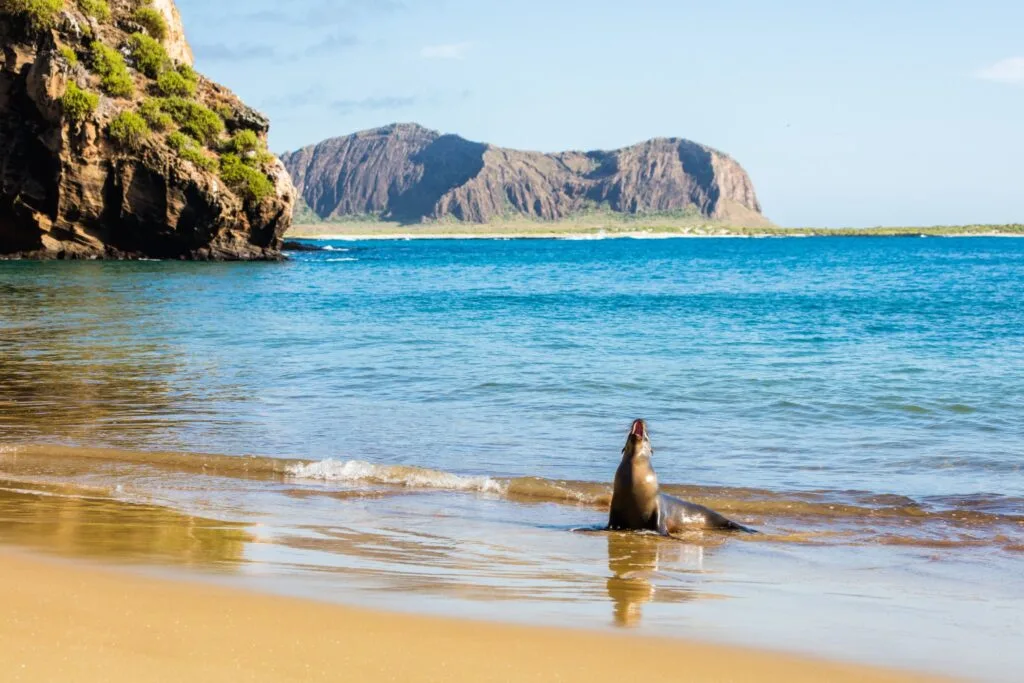
Criteria for Selecting Destinations
Choosing the perfect solo travel South America destinations requires balancing adventure with practicality, like packing just the right mix of thrill and comfort in your backpack. Safety and friendliness form the foundation of any successful solo journey. The destinations I’ve selected offer not just reasonable security levels, but also that intangible warmth of locals who genuinely enjoy meeting travelers and sharing their culture. There’s nothing quite like the feeling of being invited to join a family dinner in a Quito homestay, where laughter flows as freely as the homemade chicha, or having a local in La Paz take pride in showing you their neighborhood’s hidden gems, like a secret viewpoint overlooking the chaotic beauty of the city. These human connections turn potential isolation into enriching bonds, reminding us that solo travel is about independence, not loneliness.
Ease of travel can make or break a solo adventure. The best destinations feature reliable public transportation, good flight connections to other South American cities, and costs that won’t drain your travel fund before you’ve barely scratched the surface. I’ve learned through my own mishaps – like that time I missed a bus in Bolivia and ended up hitchhiking with a truck full of alpacas (true story, and hilariously memorable) – that the most memorable journeys often happen when you’re not constantly worried about logistics or budget constraints. For instance, budget flights within the continent can cost as little as $30-60 USD, and daily expenses in these spots average $40-70 USD for food, transport, and activities.
Activity diversity ensures you’ll never run out of inspiration, keeping your solo trip to South America fresh and exciting. The ideal solo travel South America destinations blend natural wonders like Bolivia’s surreal salt flats with historical significance such as Peru’s Inca ruins, outdoor adventures like surfing in Brazil with cultural immersion in Colombian coffee farms, and quiet contemplation in Chilean vineyards with vibrant nightlife in Argentine tango halls. This variety also means you can adapt your plans based on your mood, weather, or the fascinating people you meet along the way – perhaps swapping a hike for a spontaneous salsa lesson when rain hits.
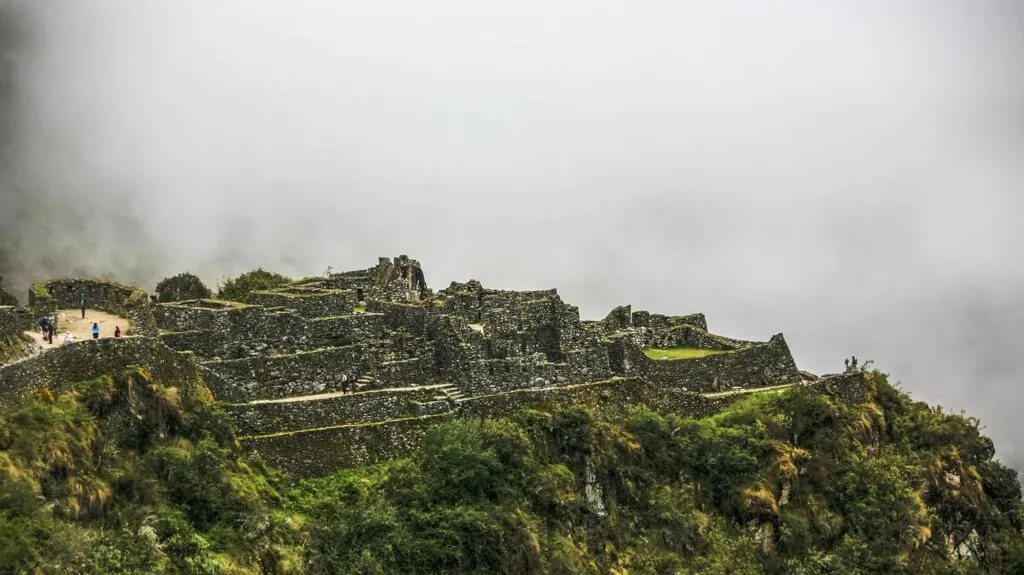
Community atmosphere distinguishes truly solo-friendly destinations from merely tourist-heavy locations. The best places foster connections through excellent hostel scenes (with dorms averaging $10-20 USD per night across these spots), homestay opportunities that cost $15-30 USD and offer home-cooked meals, and small group tours where solo travelers naturally gravitate toward each other. These connections often become the most treasured memories of any journey, like the time I bonded with a group of adventurers over a bonfire in the Sacred Valley, sharing stories that inspired me to extend my trip.
Finally, distinctive experiences separate South America from any other continent. Each destination on this list offers something authentically South American – experiences you simply cannot replicate anywhere else in the world, from tasting the world’s best ceviche in Peru to witnessing the raw power of nature in Ecuador’s volcanoes. These moments provide deeper insights into resilience, community, and joy, inspiring you to embrace life’s uncertainties with open arms.
Top Destinations for Solo Travellers in 2026
1. Cusco & Sacred Valley, Peru
Cusco captures the heart of every solo traveler who walks its cobblestone streets, where the air hums with ancient energy and every corner whispers tales of empires long gone. This ancient Inca capital, perched dramatically at 11,000 feet above sea level, serves as the gateway to Machu Picchu, but it’s so much more than just a stopover – it’s a living museum where history dances with modernity. Imagine wandering through the Plaza de Armas at dawn, the golden light illuminating colonial balconies as street vendors set up stalls brimming with colorful textiles and aromatic herbs, and you, the intrepid explorer, sipping on a $2 USD fresh juice while plotting your day. The city itself pulses with indigenous culture, colonial architecture that tells stories of conquest and fusion, and an incredibly welcoming atmosphere for independent travelers that makes you feel like you’ve found a second home.
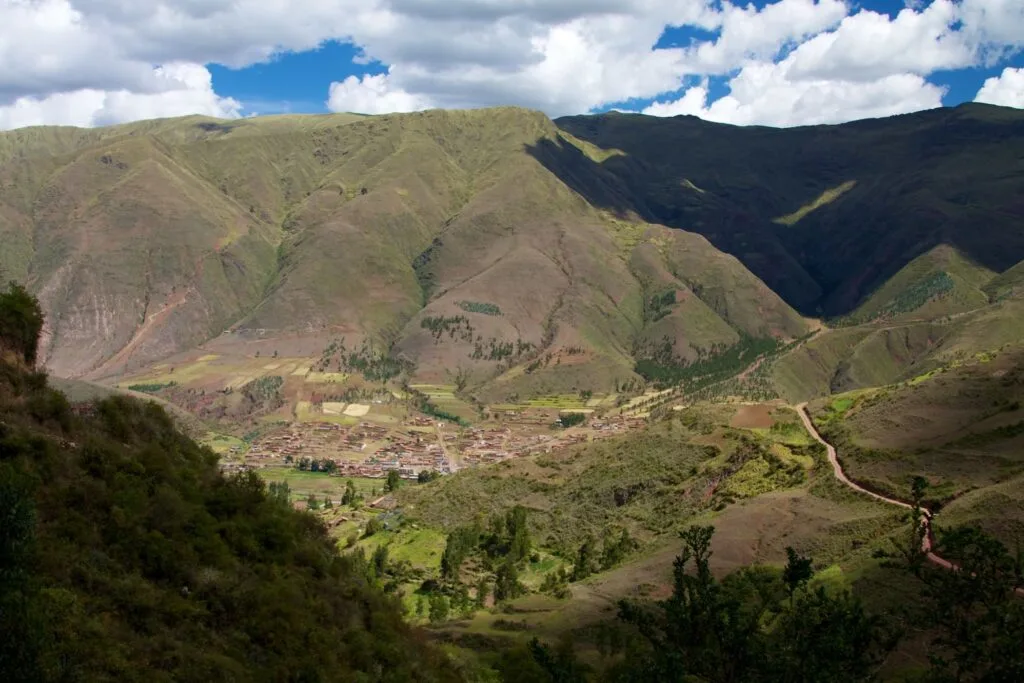
The hostel scene in Cusco ranks among South America’s best, with establishments that feel more like cultural centers than mere accommodations, offering dorm beds for $8-15 USD per night. You’ll find yourself sharing coca tea with fellow adventurers from around the world, planning treks together over communal dinners that cost just $5-10 USD, and forming friendships that often extend far beyond your travels – like the Aussie hiker I met who became my travel buddy for weeks. The city’s compact historic center makes it perfect for solo exploration, with every turn revealing ancient Inca stonework that fits together without mortar (a mind-blowing engineering feat from 500 years ago), vibrant markets like San Pedro where you can haggle for alpaca wool scarves for $10 USD, or charming cafés where you can plan your next adventure over a $3 USD cappuccino.
Group trekking opportunities abound, from the famous Inca Trail (a 4-day classic costing $500-700 USD including permits, guides, and meals, where the challenge builds camaraderie) to lesser-known but equally spectacular routes through the Sacred Valley, like the Salkantay Trek for $200-300 USD. Food tours reveal the incredible diversity of Peruvian cuisine, from street-side anticuchos (grilled heart skewers for $2 USD) to high-end tasting menus at $20-40 USD, while cultural workshops teach you traditional weaving techniques for $15 USD or how to prepare authentic ceviche in a hands-on class for $25 USD. The beauty of Cusco for solo travelers lies in how naturally these experiences lend themselves to meeting like-minded adventurers who share your passion for authentic cultural immersion, providing deeper insights into Peru’s resilient indigenous heritage and inspiring you to see the world through a lens of wonder and connection. It’s the kind of place where a simple walk can turn into a profound lesson in history, and a casual chat can spark a lifelong friendship.
2. Medellín, Colombia
Medellín’s transformation from a city once synonymous with danger to a beacon of innovation and culture represents one of South America’s most inspiring stories, a testament to human resilience and creativity that will leave you in awe. Picture arriving in this “City of Eternal Spring,” where the temperature hovers around a perfect 72°F year-round, and being greeted by the lush green hills that cradle the urban sprawl like a natural embrace. Today’s Medellín welcomes solo travelers with open arms, offering a perfect blend of urban sophistication and warm Colombian hospitality that makes independent exploration both safe and rewarding – think locals insisting you try their abuela’s arepas, turning a solo meal into a heartfelt conversation.

The modern metro system, considered one of South America’s best, makes navigating the city effortless for solo travelers, with fares at $0.70-1 USD per ride and spotless cars that double as public art galleries. The cable cars that extend the metro into the hillside communities offer breathtaking views while providing access to some of the city’s most vibrant neighborhoods, like Comuna 13, where a guided tour costs $20-30 USD and reveals stories of hope amid murals. Street art tours reveal incredible murals that tell the story of the city’s transformation, often led by local artists who share personal perspectives on their community’s evolution for $15-25 USD, adding layers of insight into social change.
Colombian coffee culture creates natural opportunities for solo travelers to connect with locals and fellow travelers alike, with farm tours in nearby areas costing $30-50 USD including tastings of world-class brews. The city’s numerous coffee shops serve as informal community centers where conversations flow as smoothly as the perfectly brewed coffee, often for just $1-2 USD a cup. Nightlife in Medellín strikes the perfect balance for solo travelers – friendly and vibrant without being overwhelming or unsafe, with salsa clubs charging $5-10 USD entry where you can learn moves from enthusiastic partners. The locals’ genuine warmth means you’ll rarely feel truly alone, even when exploring independently; it’s a place that humanizes urban renewal, inspiring you with tales of innovation like the escalators in Comuna 13 that revolutionized daily life. Hostels here offer dorms for $10-20 USD per night, often with rooftops for sunset yoga or group barbecues, turning solo trips into shared adventures full of laughter and deeper cultural understanding.
3. Buenos Aires, Argentina
Buenos Aires seduces every solo traveler who experiences its intoxicating blend of European elegance and Latin passion, like a passionate tango that sweeps you off your feet. Known as the “Paris of South America,” this magnificent city offers sophisticated urban experiences while maintaining an accessibility that makes solo exploration both comfortable and enriching. Envision strolling down wide boulevards lined with jacaranda trees in bloom, the purple petals carpeting the sidewalks as you duck into a historic café for a $2 USD medialuna pastry, feeling like you’ve stepped into a romantic novel.
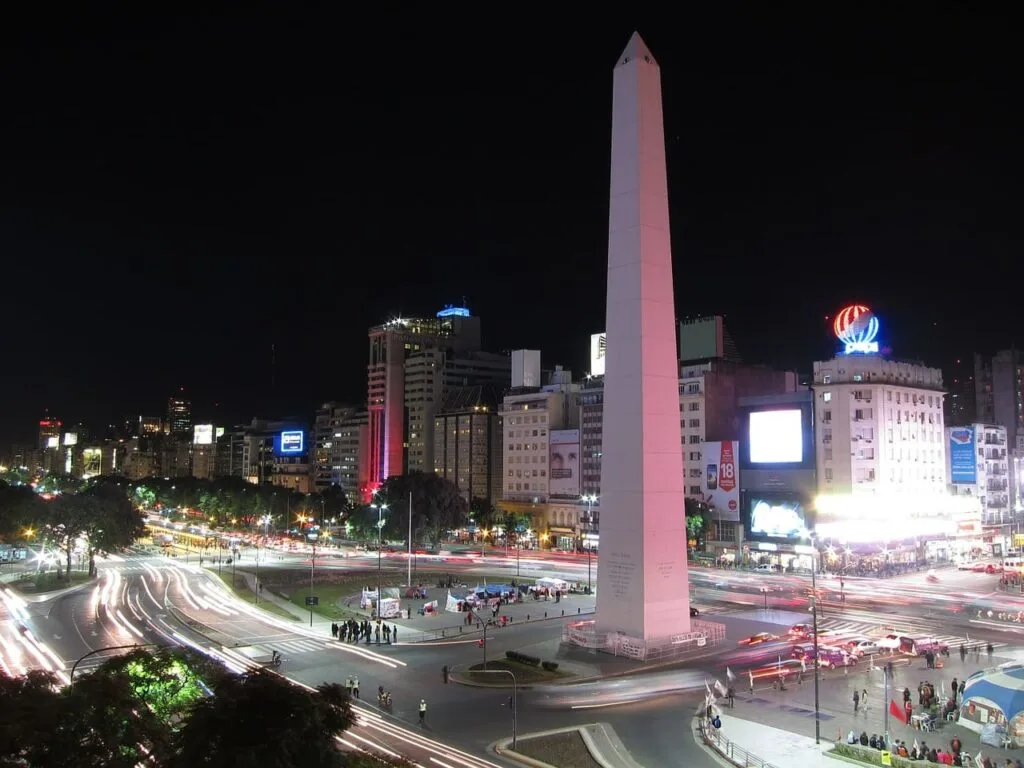
The tango scene provides a perfect entry point for solo travelers looking to immerse themselves in authentic Argentine culture, with beginner classes at milongas costing $10-20 USD where the embrace of a dance partner teaches vulnerability and connection. Many milongas (tango halls) welcome beginners, and the learning process naturally creates connections with both locals and fellow travelers – even if you trip over your feet, the laughter shared makes it fun. Even if you never master the steps, watching expert dancers interpret this passionate music offers insights into the Argentine soul, revealing themes of longing and resilience born from the country’s immigrant history.
Café culture in Buenos Aires elevates people-watching to an art form, with legendary spots like Café Tortoni (entry free, coffee $3-5 USD) where you can spend hours, many of which have hosted famous writers and intellectuals for over a century. The artistic neighborhoods of La Boca and Palermo offer distinctly different experiences – La Boca with its colorful Caminito street and tango performances (shows $20-40 USD), where the vibrant houses tell stories of Italian immigrants, and Palermo with its trendy boutiques, sophisticated restaurants offering steak dinners for $15-25 USD, and vibrant nightlife scene that welcomes solo adventurers with open-mic nights or craft beer bars at $5-10 USD a pint. Hostels in this dynamic city provide dorms for $10-15 USD per night, often organizing group asados (barbecues) that foster friendships. Buenos Aires humanizes passion, inspiring deeper insights into cultural fusion and encouraging you to embrace life’s rhythms with flair and fun.
4. Santiago & Valparaíso, Chile
Chile’s central region offers solo travelers two complementary experiences that showcase the country’s remarkable diversity, like a perfectly paired wine and cheese – one urban and polished, the other bohemian and raw. Santiago, the modern capital nestled against the dramatic Andes backdrop that looms like silent guardians, provides urban sophistication and serves as an excellent base for mountain adventures. The city’s efficient metro system (fares $0.80-1 USD) and general safety make it ideal for solo exploration, while the nearby mountains offer everything from world-class skiing (day passes $40-60 USD) to challenging hiking trails like Cerro Provincia for free, where the panoramic views reward your sweat with profound moments of solitude and triumph.
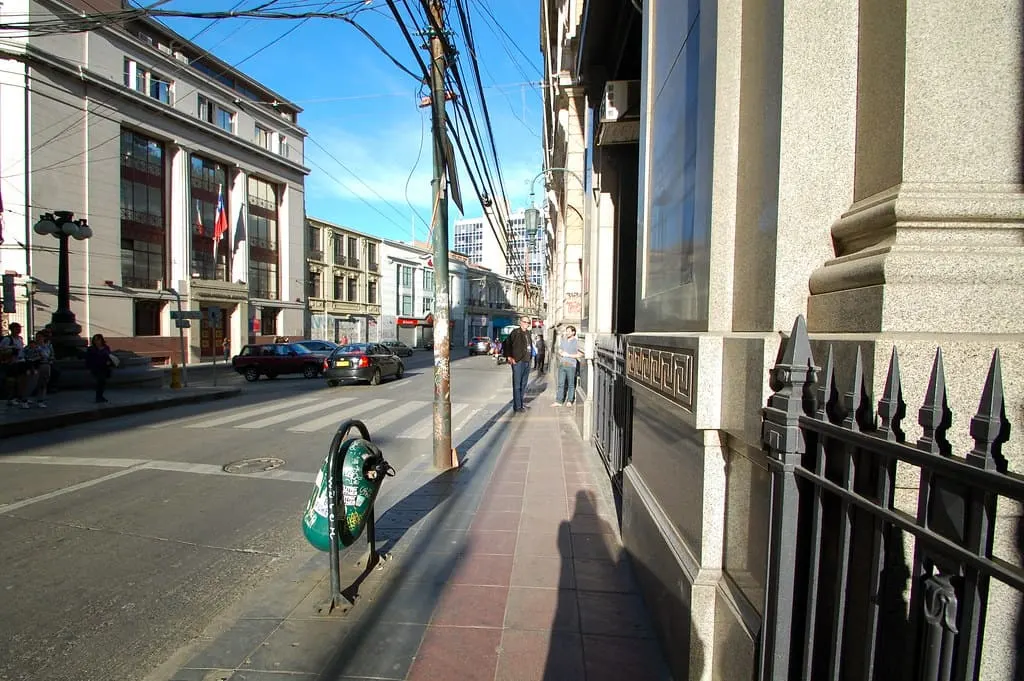
Just two hours away by bus ($5-10 USD), Valparaíso presents a completely different face of Chile – a bohemian port city where hills tumble into the sea like a colorful cascade. This UNESCO gem, with its famous street art covering seemingly every available wall, feels like an open-air gallery where solo travelers can spend days discovering new artistic treasures on free walking tours (tip-based, $5-10 USD suggested). The city’s unique topography, built across dozens of hills connected by historic funiculars ($0.50 USD per ride), creates intimate neighborhoods perfect for solo wandering, stumbling upon hidden viewpoints or quirky cafes serving empanadas for $2 USD.
The proximity to Casablanca Valley wine region adds another dimension to the solo travel experience, with many wineries offering tours specifically designed for individual travelers costing $20-50 USD, providing opportunities to learn about Chilean wine-making (from crisp Sauvignon Blancs to bold Carmeneres) while meeting fellow wine enthusiasts from around the world over tastings. Hostels in both cities offer dorms for $10-18 USD per night, often with organized hikes or art workshops. The combination of urban culture, artistic expression, and world-class wine creates a perfect trifecta for solo travel South America adventures, humanizing Chile’s story of natural beauty and cultural revival, inspiring insights into sustainability and creativity that linger long after you leave.
5. Quito, Ecuador
Quito’s dramatic setting at 2,850 meters above sea level creates an immediately memorable first impression for solo travelers, where the city sprawls like a jewel in the Andes, flanked by volcanoes that remind you of nature’s raw power. The UNESCO World Heritage historic center, with its incredibly preserved colonial architecture featuring ornate balconies and gilded churches, offers days of solo exploration through narrow streets lined with baroque masterpieces and charming plazas where local life unfolds at a relaxed pace – imagine sipping a $1 USD canelazo (hot spiced drink) while watching artisans craft intricate silver jewelry.
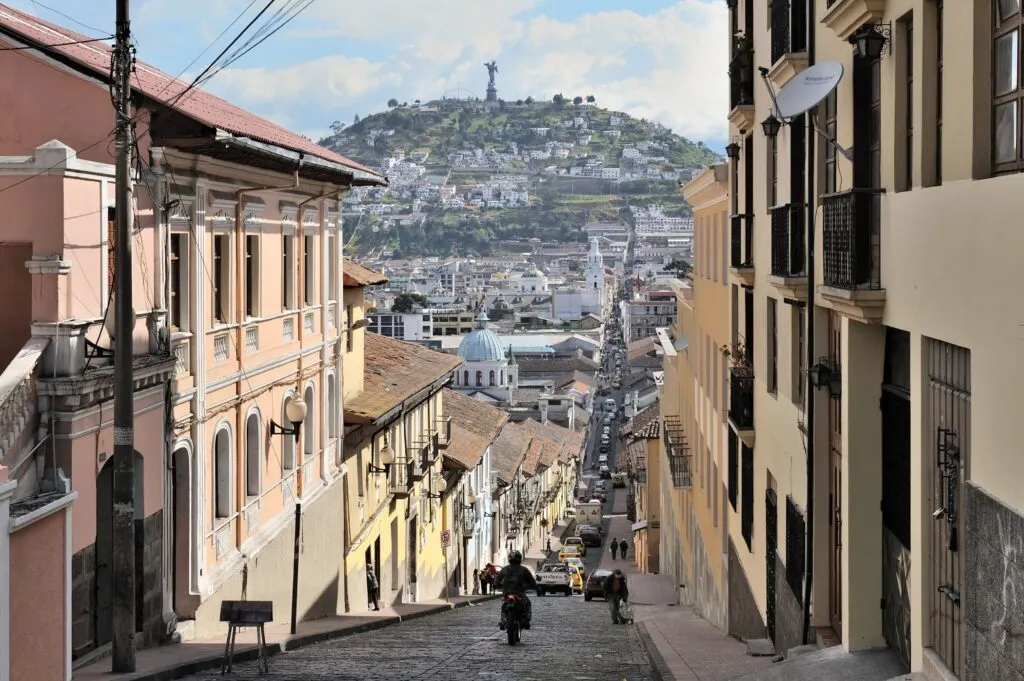
The city serves as the perfect launching point for Galápagos adventures (flights $200-300 USD round-trip), but many solo travelers discover that Quito itself deserves much more than just a stopover, with its blend of colonial history and modern indigenous pride providing deeper insights into Ecuador’s multicultural fabric. The strong international traveler community means you’ll easily find companions for everything from volcano climbing (Cotopaxi day trips $50-80 USD) to salsa dancing classes ($10-15 USD), where the rhythmic beats teach coordination and joy. Hostels and guesthouses cater specifically to solo adventurers, offering dorms for $8-15 USD per night and often organizing group activities like market visits or providing valuable local insights on avoiding altitude sickness with herbal remedies.
Ecuador’s compact size makes Quito an excellent base for diverse experiences – you can explore Amazon rainforest lodges ($100-150 USD for 2 days), climb snow-capped volcanoes for $40-60 USD guided hikes, and relax in hot springs spas for $10-20 USD entry, all within a few hours of the capital. This accessibility, combined with Ecuador’s use of the US dollar (no currency headaches!), makes it particularly appealing for solo travelers planning extended South American journeys. Quito humanizes high-altitude living, inspiring with stories of resilience against earthquakes and volcanoes, turning your trip into a vivid tale of adventure and cultural depth that motivates you to seek out the extraordinary in the everyday.
6. La Paz, Bolivia
La Paz commands attention as the world’s highest capital city, where the thin air and dramatic setting create an otherworldly atmosphere that captivates solo travelers from the moment of arrival – think landing at the airport and gazing down at a bowl-shaped valley filled with red-brick buildings clinging to impossible slopes. The unique cable car system, originally built for practical transportation but now a tourist attraction in itself (rides $0.50 USD), offers spectacular views of the city sprawling across the altiplano, like a giant urban puzzle.
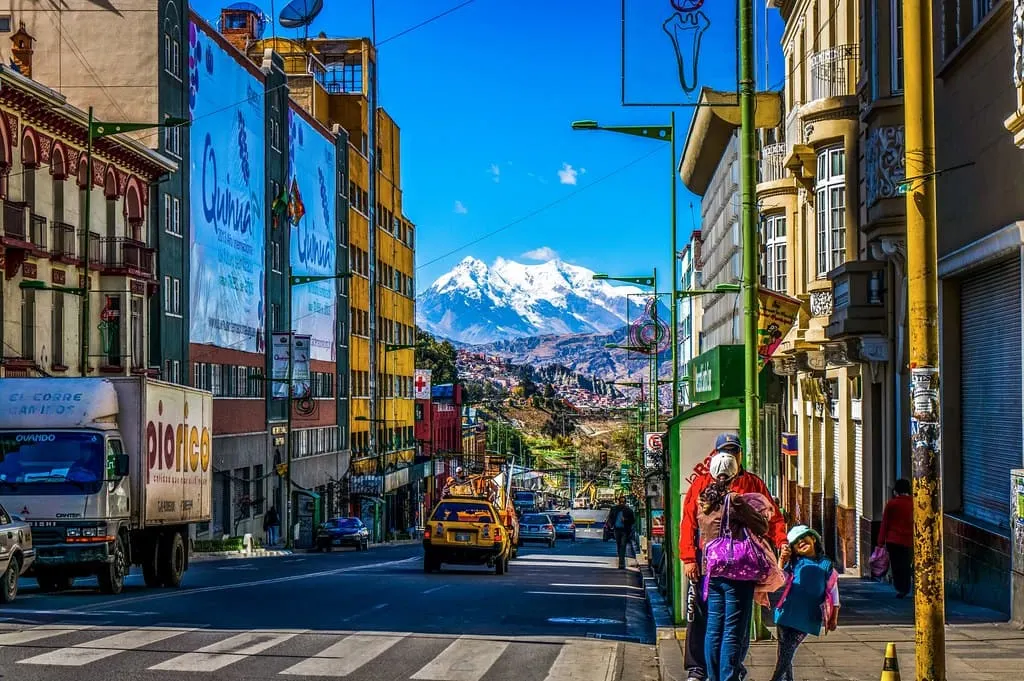
The indigenous culture remains vibrantly alive in La Paz, providing solo travelers with authentic cultural experiences rarely found in more touristy destinations, such as the famous witch markets where you can browse herbs and talismans for $5-10 USD while learning about Aymara beliefs that blend Catholicism with ancient rituals. The surrounding neighborhoods showcase daily life largely unchanged by globalization, offering glimpses into resilient communities that thrive at 12,000 feet – a humbling insight into human adaptation.
This authenticity, combined with generally safe conditions for solo travelers, creates opportunities for meaningful cultural exchange, like joining a cholita wrestling match for $5 USD entry, where empowered indigenous women flip stereotypes (and opponents) in colorful skirts. La Paz serves as the gateway to some of South America’s most spectacular natural wonders, including the otherworldly Uyuni Salt Flats (3-day tours $150-200 USD including meals and lodging). Tour operators cater specifically to solo travelers, creating small groups that often develop strong bonds while exploring these incredible landscapes together – the shared experience of sunrise over the world’s largest salt flat, with its perfect mirror reflections, creates connections that often last long after the journey ends, inspiring reflections on vastness and unity. Hostels offer dorms for $5-10 USD per night, with many hosting trivia nights or cooking classes for extra fun, humanizing Bolivia’s highland spirit and encouraging you to embrace the unexpected with humor and heart.
7. Florianópolis, Brazil
Florianópolis, known locally as “Floripa,” offers solo travelers a different side of Brazil – one focused on natural beauty, outdoor adventures, and a relaxed beach culture that welcomes independent travelers with open arms, like a warm ocean wave inviting you to dive in. This island destination, often called “Magic Island,” combines pristine beaches with excellent surfing, creating a paradise for solo travelers seeking both relaxation and adventure – imagine waking to the sound of crashing waves, grabbing a $2 USD acai bowl, and deciding whether to chase swells or lounge under palms.
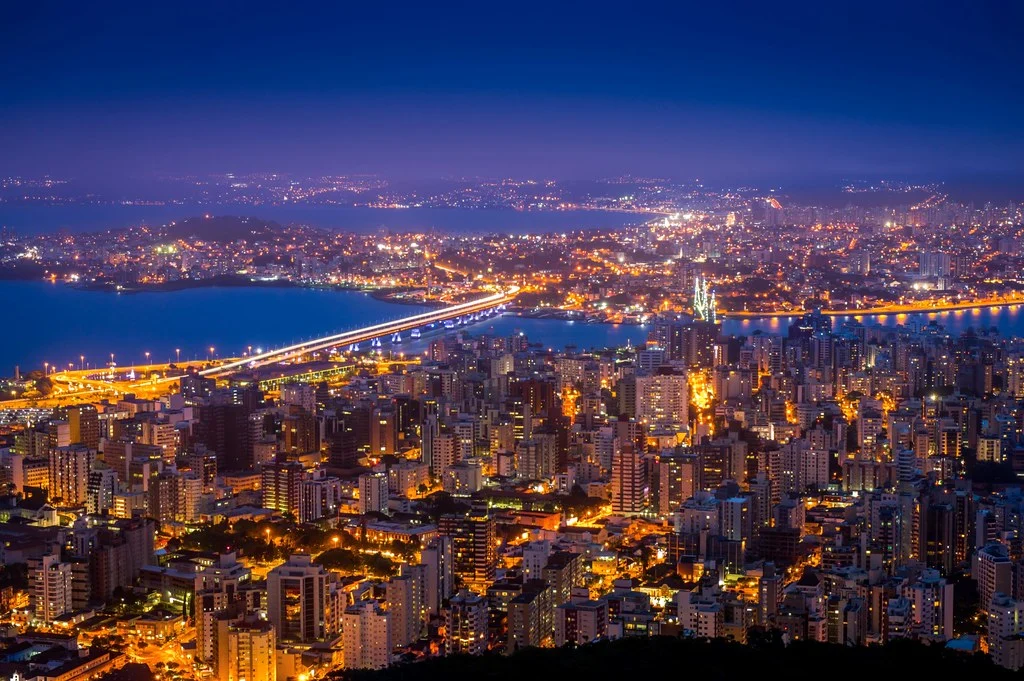
The beachside hostel scene in Florianópolis ranks among South America’s most social and welcoming, with dorms costing $10-15 USD per night. These establishments often organize group activities, from surfing lessons ($20-40 USD for a 2-hour session) to beach volleyball tournaments, making it incredibly easy for solo travelers to connect with like-minded adventurers – I once joined a impromptu bonfire jam session that turned into an all-night storytelling fest. The laid-back atmosphere means pressure-free socializing where friendships develop naturally over shared sunsets and caipirinhas ($3-5 USD each), fostering a sense of community amid paradise.
The island’s 42 beaches ensure variety for every type of solo traveler. Whether you prefer the vibrant beach club scene of Jurerê Internacional (entry $10-20 USD), the consistent surf breaks of Praia Mole where board rentals are $10 USD per day, or the tranquil natural pools of Lagoinha do Leste reached by a scenic hike (free, but pack snacks), you’ll find your perfect beach paradise. The reliable public transportation system makes beach-hopping easy and affordable for solo adventurers, with buses at $1-2 USD per ride. Floripa humanizes Brazil’s coastal joy, providing deeper insights into environmental conservation (many beaches are protected) and inspiring you with its blend of fun, nature, and camaraderie that makes solo travel feel like a celebration.
Tips for Solo Travellers in South America
Learning basic Spanish phrases transforms solo travel South America experiences from good to extraordinary, like unlocking a secret door to hidden gems. Even simple greetings like “buenos días” or polite expressions such as “por favor” open doors to authentic interactions that would otherwise remain closed – locals appreciate the effort and often respond with increased warmth and helpfulness that can completely change your travel experience, perhaps leading to an invitation to a local fiesta or insider tips on the best viewpoints.
Safety consciousness should enhance rather than restrict your adventures. Choose accommodations in well-regarded neighborhoods (hostel staff are goldmines for advice), trust your instincts about situations and people – if something feels off, pivot like a tango dancer – and maintain communication with friends or family back home via apps like WhatsApp. Most solo travelers find South America much safer than media portrayals suggest, but reasonable precautions ensure peace of mind that allows full enjoyment of your adventures, turning potential worries into confident strides.
Joining walking tours ($5-15 USD tip-based), cooking classes ($20-40 USD), or volunteer activities (some free, others $10-20 USD per day) provides natural opportunities to meet fellow travelers and locals alike. These shared experiences often lead to lasting friendships and travel companions for subsequent destinations – picture bonding over kneading dough in a Peruvian class, laughing at your lumpy empanadas. Many solo travelers find their best South American memories come from unexpected connections made during organized activities, adding layers of fun and insight.
Technology can be your solo travel ally when used wisely. Ride-hailing apps like Uber and Cabify operate in most major South American cities, providing safe transportation options for $3-10 USD per ride. Translation apps help bridge language barriers, while travel apps connect you with local recommendations and fellow travelers. However, don’t let technology replace real-world interactions and spontaneous discoveries – put the phone down and let serendipity guide you to that hidden gem café.
The following tips will help ensure your solo adventure is as smooth and rewarding as possible, blending practicality with the thrill of discovery.
Practical Tips for a Smooth Trip
- Cash is Still King: While major cities accept cards, many small businesses, market stalls, and rural areas operate on a cash-only basis. It’s wise to carry a mix of small and large denominations in local currency, withdrawing from ATMs in secure locations (fees $3-5 USD per transaction).
- Embrace the Bus System: For long-distance travel, buses are the cheapest and most immersive way to get around, with fares $10-50 USD for overnight routes. Companies like Redbus can help you find and book tickets in advance. Opt for “cama” (bed) or “semi-cama” (semi-bed) seats for long overnight journeys—they are more expensive ($20-60 USD) but far more comfortable and safer, often with WiFi and snacks.
- Pack Smart, Pack Light: Layers are your best friend in varying altitudes. A good pair of breathable hiking pants ($30-50 USD), a packable rain jacket ($20-40 USD), and comfortable, worn-in walking shoes ($50-80 USD) will serve you well. A small daypack for daily essentials is also a must, and don’t forget altitude sickness remedies like ibuprofen ($5 USD pack).
- Stay Connected: Before you arrive, check if your phone is unlocked and consider buying a local SIM card (e.g., Claro or Movistar) for $5-10 USD to get affordable data (plans $10-20 USD for 1-2GB). This makes navigation and communication effortless, especially for solo travelers.
- Use Offline Apps: Downloading maps and language packs before you leave your accommodation is a game-changer. Apps like Google Maps and Maps.me allow you to navigate without an internet connection, which is invaluable when you’re in a new city or on a remote trail. The offline feature on Google Translate is also essential, saving you from awkward charades moments.
Safety and Security
- Protect Your Valuables: When in crowded areas like bus terminals or markets, keep your bag in front of you. A money belt worn under your clothes ($10-15 USD) is an excellent way to secure your passport, extra cash, and credit cards, adding peace of mind without cramping your style.
- Be Street Smart: Avoid walking around alone at night, especially in unfamiliar neighborhoods. When possible, use ride-hailing apps or pre-booked taxis ($5-15 USD) rather than hailing a cab on the street – they’re tracked and safer.
- Listen to Local Advice: The staff at your hostel or guesthouse are an invaluable resource. Ask them about which areas to avoid, what the safest modes of transportation are, and any local scams to watch out for – their insights can turn a good trip into a great one.
- Don’t Flash Your Wealth: Blending in is key. Leave expensive jewelry at home, and avoid using your phone openly in public. Be aware of your surroundings, and if a situation feels off, trust your gut and leave immediately – better a detour than a drama.
Making Friends on the Road
- Stay in Hostels: Even if you’re not a backpacker, hostels are the single best way to meet other travelers, with dorms $8-20 USD per night. Look for ones with good reviews for their social atmosphere. Many have common areas, bars, or kitchens that are perfect for striking up conversations over a shared meal.
- Take a Class: Sign up for a cooking class ($20-40 USD), a language lesson ($10-20 USD), or a dance workshop ($15-25 USD). These activities are not only fun but also bring together people with a shared interest, making it easy to connect – plus, you leave with new skills and stories.
- Join a Free Walking Tour: These tours are a great way to get a feel for a new city and meet other solo travelers on the first day. They are often tip-based ($5-10 USD), so they’re budget-friendly and attract a diverse group of people, sparking conversations that lead to group dinners or side trips.
Conclusion
South America in 2026 stands ready to embrace free-spirited solo travelers with experiences that will reshape how you see both the world and yourself, like a transformative journey where every step uncovers a new layer of your own potential. This incredible continent offers something precious – the perfect balance between adventure and accessibility, between challenge and comfort, between independence and connection that humanizes travel in profound ways. From the mystical mountains of Peru, where ancient ruins whisper secrets of lost civilizations, to the artistic streets of Valparaíso alive with murals that tell tales of rebellion and beauty, from the innovative spirit of Medellín that showcases human triumph over adversity to the tango passion of Buenos Aires that ignites your inner fire, every destination on this list offers unique opportunities to discover not just new places, but new aspects of your own character.
The natural wonders will leave you speechless, like the mirror-like reflections in Uyuni that make you ponder infinity, while the cultural experiences will broaden your perspective, such as weaving with indigenous artisans in Cusco that connects you to timeless traditions. And the people you meet – oh, the people! – will become part of your story forever, from the surfer in Floripa who teaches you to ride waves (and life’s ups and downs) to the Quito local sharing volcano lore over a beer. Solo travel South America adventures in 2026 promise more than just stamps in your passport – they offer transformation, with budgets as low as $40-70 USD per day making it accessible.
Whether you find yourself sharing stories with fellow travelers in a Cusco hostel over $5 USD pisco sours, learning to surf on the beaches of Florianópolis with lessons that build confidence and camaraderie, or watching the sunrise over the Uyuni Salt Flats with newfound friends amid a landscape that feels extraterrestrial, you’ll discover that traveling alone doesn’t mean being lonely. Pick a destination from this list and start your solo journey – in South America 2026, you’ll never really be alone! The continent’s warm embrace awaits, ready to welcome you into its community of dreamers, adventurers, and seekers who understand that sometimes the best company is the one you discover along the way, inspiring you to live boldly, connect deeply, and return home with a heart full of stories and a soul forever changed.
FAQs for Solo Travel in South America 2026
Is South America safe for solo travelers in 2026?
South America is generally safe for solo travelers if you take reasonable precautions. Destinations like Cusco, Medellín, and Florianópolis have improved safety records and welcoming atmospheres, with reliable public transport and tourist-friendly areas. Always stay in well-reviewed neighborhoods, use ride-hailing apps like Uber ($3-10 USD per ride), avoid flashing valuables, and trust local advice from hostel staff about areas to avoid. For example, Medellín’s metro system is secure and affordable ($0.70-1 USD per ride), and Buenos Aires is known for its safe café culture. Trust your instincts, and you’ll find most locals are warm and eager to help.
What is the best time to visit South America for solo travel?
The best time depends on your destination, but 2026 offers great weather windows. For Peru (Cusco, Machu Picchu), the dry season (May-September) is ideal for trekking ($500-700 USD for Inca Trail), with clear skies and temperatures around 65-75°F. Brazil’s Florianópolis shines in summer (December-February), perfect for beach activities ($10-40 USD for surf lessons) with warm 75-85°F days. For Bolivia’s Uyuni Salt Flats, aim for the wet season (December-March) for mirror-like reflections ($150-200 USD for tours), though dry season (June-August) is great for crisp views. Check local festivals, like Carnaval in February, for extra cultural fun.
How much does solo travel in South America cost in 2026?
Solo travel in South America is budget-friendly, with daily costs averaging $40-70 USD. Hostels offer dorms for $8-20 USD per night across destinations like Quito or La Paz. Meals range from $2 USD street food (empanadas in Santiago) to $15-40 USD for restaurant dining in Buenos Aires. Transport is affordable—buses cost $10-50 USD for long routes, metro rides $0.50-1 USD, and budget flights $30-60 USD between cities. Activities like walking tours ($5-15 USD tip-based) or cultural classes ($15-40 USD) keep costs low. Carry cash for markets ($3-5 USD ATM fees), and plan $200-300 USD for multi-day adventures like Uyuni tours.
Do I need to speak Spanish for solo travel in South America?
Basic Spanish phrases significantly enhance your experience but aren’t mandatory. In tourist hubs like Cusco or Buenos Aires, many locals and hostel staff speak some English, and translation apps like Google Translate (offline mode recommended) bridge gaps. Learning simple greetings like “hola” or “gracias” ($10-20 USD for a language class) opens doors to authentic interactions, like chatting with vendors in La Paz’s witch markets. In less touristy areas, like rural Sacred Valley, basic Spanish or a phrasebook ($5-10 USD) helps navigate menus or transport, making your journey smoother and more immersive.
What are the best ways to meet people while solo traveling in South America?
South America’s vibrant community atmosphere makes meeting people easy. Stay in hostels ($8-20 USD per night) with social spaces—Cusco and Florianópolis have top-rated ones with group activities like barbecues or trivia nights. Join free walking tours ($5-10 USD tip-based) in cities like Valparaíso to connect with other travelers. Cooking classes ($20-40 USD), dance workshops ($10-25 USD), or volunteer programs ($10-20 USD/day) in Quito or Medellín spark natural friendships. Coffee shops ($1-2 USD coffee) or tango nights in Buenos Aires ($10-20 USD classes) also create casual meetups, turning solo trips into shared adventures.
How do I get around South America as a solo traveler?
South America’s transport infrastructure in 2026 is solo-traveler-friendly. Cities like Santiago and Medellín have efficient metros ($0.70-1 USD per ride), while ride-hailing apps like Uber ($3-10 USD) ensure safe travel. Long-distance buses ($10-60 USD for cama/semi-cama seats) connect regions, with companies like Redbus simplifying bookings. Budget airlines offer flights between hubs like Quito to Galápagos ($200-300 USD round-trip) or Cusco to La Paz ($50-60 USD). For remote areas like Uyuni, join group tours ($150-200 USD). Download offline maps (Google Maps, Maps.me) for seamless navigation, especially on hikes or in rural areas.
What should I pack for a solo trip to South America in 2026?
Pack light with versatile layers for diverse climates. Bring breathable hiking pants ($30-50 USD), a packable rain jacket ($20-40 USD), and sturdy walking shoes ($50-80 USD) for treks in Cusco or Valparaíso’s hills. A small daypack ($15-30 USD) is essential for daily outings. Include altitude sickness remedies like ibuprofen ($5 USD) for La Paz or Quito. Carry a reusable water bottle ($10 USD) and a money belt ($10-15 USD) for valuables. Download offline apps before departure, and pack a universal adapter ($10 USD) for charging. Beach gear like quick-dry towels ($15 USD) suits Florianópolis, while a warm fleece ($20-40 USD) is key for Andean nights.
Are there visa requirements for solo travel in South America in 2026?
Many South American countries offer visa-free entry for up to 90 days for US, Canadian, EU, and Australian passports, including Peru, Colombia, Argentina, Chile, Ecuador, and Brazil. Bolivia may require a visa for some nationalities ($50-160 USD, depending on country), but applications are simplified online or at borders. Always check current policies on official government websites or with embassies, as requirements can shift. For extended stays, consider e-visas where available (processing $20-50 USD). Carry digital and physical copies of your passport, and ensure it’s valid for six months beyond your travel dates.
What unique experiences can solo travelers expect in South America?
South America offers unparalleled experiences: trek the Inca Trail to Machu Picchu ($500-700 USD) for ancient wonder, join a coffee farm tour in Medellín ($30-50 USD) to taste world-class brews, or learn tango in Buenos Aires ($10-20 USD classes) for cultural passion. Explore Valparaíso’s street art (free tours, $5-10 USD tips) or witness Uyuni’s surreal salt flats ($150-200 USD tours). In Quito, climb volcanoes ($40-80 USD) or visit Galápagos ($200-300 USD flights). Florianópolis offers surfing ($20-40 USD lessons) and beach-hopping ($1-2 USD bus rides), blending adventure with relaxation, all fostering deeper cultural insights.
How can I stay connected while solo traveling in South America?
Staying connected is easy with local SIM cards (Claro, Movistar) costing $5-10 USD for 1-2GB data plans ($10-20 USD) in cities like Santiago or Cusco. Most hostels ($8-20 USD per night) and cafés ($1-2 USD coffee) offer free WiFi, though speeds vary. Download offline apps like Google Maps or Translate for remote areas like the Sacred Valley or Uyuni. WhatsApp is widely used for communication with locals or tour operators. For emergencies, keep a list of local contacts and embassy numbers. Data ensures you can book tours, navigate, or share sunset selfies with newfound friends.

I’m Clara Brooks, a passionate travel writer and narrative architect with a gift for transforming raw adventure experiences into deeply moving stories that resonate with the human soul. With my empathetic approach to travel journalism and keen eye for authentic cultural connections, I’ve established myself as a trusted voice for travelers seeking meaningful, transformative journeys beyond the typical tourist trail.
As a contributing writer to respected travel and literary publications, my expertise extends from intimate cultural documentaries and community-focused travel narratives to wellness retreats and mindful adventure experiences. My ability to connect with local communities, uncover untold stories, and translate complex cultural experiences makes me an invaluable resource for travelers seeking depth and authenticity in their journeys.
I specialize in crafting immersive travel narratives, cultural guides, and reflective journey pieces that emphasize human connection and personal growth — helping my audience discover not just new places, but new perspectives on life and themselves. My recent works include in-depth cultural immersion guides, stories of personal transformation through travel, and sustainable community tourism initiatives.
When I’m not documenting adventures or writing from remote locations, I actively engage in cultural exchange programs, support local storytelling initiatives, and advocate for tourism that empowers and benefits local communities.
✔ Cultural Immersion & Authentic Storytelling
✔ Mindful & Transformative Travel
✔ Community-Based Tourism
✔ Travel Writing & Narrative Craft
✔ Cross-Cultural Communication
✔ Wellness & Reflective Travel Experiences